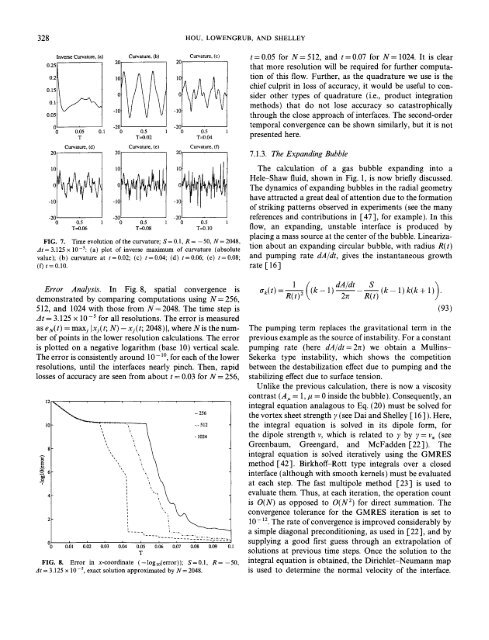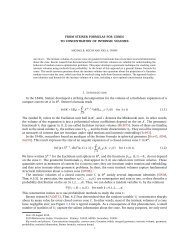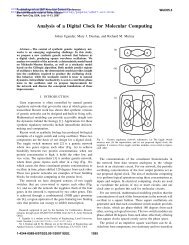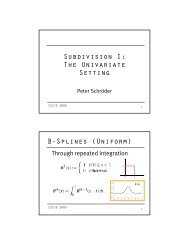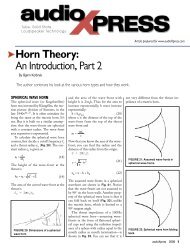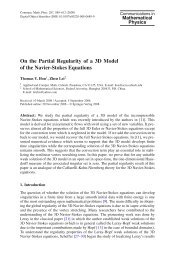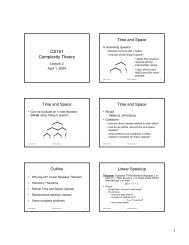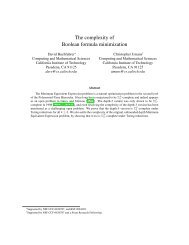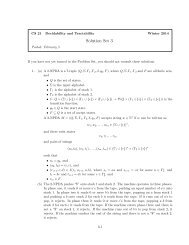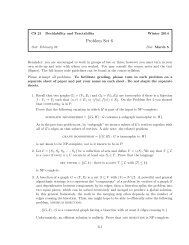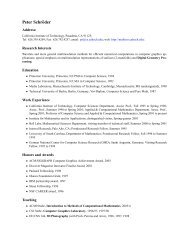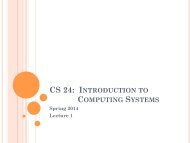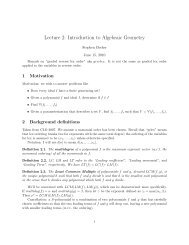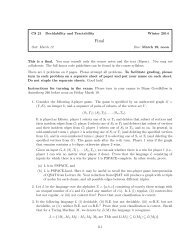FLOWS WITH SURFACE TENSION 327face tension and <strong>the</strong> unstable stratification causes <strong>the</strong> interfaceto rapidly develop a ramified spatial structure.A time sequence of inteface positions is shown in Fig. 4using N=2048 and At= 3.125 × 10 -5. The second-orderlinear propagator method is used, and <strong>the</strong> time step ischosen small enough so as to effectively eliminate time-steppingerrors <strong>from</strong> <strong>the</strong> computation. At early times, threerising and falling fingers of fluid form. As time progresses,<strong>the</strong> tips of <strong>the</strong>se fingers thicken and begin to resemblebubbles. The necks of <strong>the</strong> fastest moving fingers begin tonarrow and <strong>the</strong>ir sides approach tangentially. The o<strong>the</strong>rnecks appear to follow suit. These necks become localizedjets, fluxing fluid <strong>from</strong> <strong>the</strong> bulk into <strong>the</strong> bubbles. At latertimes, <strong>the</strong> sides of <strong>the</strong> necks seem to self-intersect or pinch.However, a close-up of <strong>the</strong> neck region (box (f)) of <strong>the</strong>topmost bubble reveals that <strong>the</strong> pinching has not yet takenplace by t = 0.10 and that <strong>the</strong> neck still has a nonzero width.As <strong>the</strong> necks narrow, however, it becomes more and moredifficult to maintain resolution. This is because <strong>the</strong> alternatepoint discretization of <strong>the</strong> Birkhoff-Rott integral requires aminimum width of six or seven grid lengths in <strong>the</strong> neckregion for accuracy [ 8 ]. This effect is illustrated in Fig. 5,where <strong>the</strong> interface positions are compared at t = 0.10 <strong>with</strong>N= 1024 and N---2048. Although pinching has alreadytaken place in <strong>the</strong> N = 1024 calculation, it is unphysical. Therrrinimum width of <strong>the</strong> neck as a function of time is shownin Fig. 6 for several spatial resolutions: N= 512, N= 1024and N=2048 (again using <strong>the</strong> same time step Lit=3.125 x 10-5). The width is computed by minimizing <strong>the</strong>distance function between <strong>the</strong> bounding curves, which arerepresented by Fourier polynomials. The width of <strong>the</strong> neckdecreases rapidly at early times. By t = 0.065 <strong>with</strong> N= 512,<strong>the</strong> neck is but one grid length wide, and <strong>the</strong> calculationbecomes inaccurate. The higher resolution calculations21.510.50-0.5-1-1.5-2 1024i0LiI 2FIG. 5. Comparison of Hele-Shaw interfaces at t = 0.10 for differentspatial resolutions: <strong>the</strong> left corresponds to N= 1024 and <strong>the</strong> right toN=2048; S=0.1, R= -50, At= 3.125 x l0 -5.)L32O480.12-- 512-.- 10240.1 - 20480.08~ 0.0~0.0,t0.020 5 6 7 8 :, 10T x 10 .2FIG. 6. Minimum distance to pinching for N= 512, N= 1024, andN= 2048; S = 0.1, R = -50, At = 3.125 x 10 -5.indicate that <strong>the</strong> narrowing slows shortly <strong>the</strong>reafter.However, by t = 0.08, <strong>the</strong> N = 1024 calculation has a neckwidth of only five grid lengths, and that calculation becomesinaccurate. But by using N = 2048, <strong>the</strong> width is seen tosaturate after t= 0.08 and shows only a slight fur<strong>the</strong>rdecrease by t = 0.10. The neck region is 11 of its grid lengthswide. Presumably, <strong>the</strong> width of <strong>the</strong> neck region scales <strong>with</strong><strong>the</strong> surface tension, although this has not been studied indetail.This lack of self-intersection in <strong>the</strong> neck region is consistent<strong>with</strong> behavior found by Goldstein, Pesci, and Shelley[ 18 ] in asymptotic models of jets in Hele-Shaw flows. Theirmodelling suggests also that <strong>the</strong> minimum neck widthdecreases by a factor of two <strong>with</strong> a fourfold decrease in <strong>the</strong>surface tension. It is only in <strong>the</strong> limit of zero surface tensionthat <strong>the</strong>ir model equation predicts <strong>the</strong> breaking of <strong>the</strong> neck.They do consider o<strong>the</strong>r cases, however, where <strong>the</strong> surfacetension does not prevent <strong>the</strong> pinching of material interfaces.Figure 7 shows <strong>the</strong> evolution of <strong>the</strong> curvature. The topleft plot shows <strong>the</strong> inverse of <strong>the</strong> maximum absolute curvature.Vanishing in this plot would correspond to adivergence of <strong>the</strong> curvature. At early times, <strong>the</strong>re is a rapidincrease in <strong>the</strong> curvature (a decrease in <strong>the</strong> plot). It peaksaround t= 0.015 and <strong>the</strong>n begins to decrease. This lastsuntil t -- 0.05. The curvature <strong>the</strong>n refocuses and <strong>the</strong> processrepeats itself several times. By <strong>the</strong> end of <strong>the</strong> computation,<strong>the</strong> curvature has nearly reached again its peak at t = 0.015.The o<strong>the</strong>r plots in Fig. 7 show x as a function of ~ at severaltimes; <strong>the</strong>se graphs indicate that in fact, <strong>the</strong> curvaturesaturates at one part of <strong>the</strong> interface and refocuses inano<strong>the</strong>r, leading to a very complicated overall structure.The boundaries of <strong>the</strong> narrow neck regions are indicated bya pairs of closely spaced peaks of like signed curvature. Thephenomenon of saturation and refocussing will be seenagain in <strong>the</strong> context of inertial vortex sheets.
328 HOU, LOWENGRUB, AND SHELLEY0.250.20.150A0.05Inverse Curvature, (a)20110101Curvature, (b)0 0.05 O. 1 0.5TT=0.02Curvature, (d)20 20110-10101O~ilCurvature, (e)Curvature, (c)-200 0.5 0.5-200.5T--0.06 T--0.08 T--0.10200-10-20 0 0.5T---0.04200-10Curvature, (f)FIG. 7. Time evolution of <strong>the</strong> curvature; S = 0.1, R = -50, N = 2048,At= 3.125 x 10-5: (a) plot of inverse maximum of curvature (absolutevalue); (b) curvature at t=0.02; (c) t=0.04; (d) t=0.06; (e) t=0.08;(f) t = 0.10.Error Analysis. In Fig. 8, spatial convergence isdemonstrated by comparing computations using N= 256,512, and 1024 <strong>with</strong> those <strong>from</strong> N= 2048. The time step isAt = 3.125 × 10-5 for all resolutions. The error is measuredas eN(t) = maxj Ixj(t; N) - xj(t; 2048)1, where Nis <strong>the</strong> numberof points in <strong>the</strong> lower resolution calculations. The erroris plotted on a negative logarithm (base 10) vertical scale.The error is consistently around 10- lO, for each of <strong>the</strong> lowerresolutions, until <strong>the</strong> interfaces nearly pinch. Then, rapidlosses of accuracy are seen <strong>from</strong> about t = 0.03 for N = 256,~ 6"712 ~ ~ . _ _113842Ci0.01 0.02 0.(13-- 256-~ -.- 512i~ - 1024' ~ .,\~,, ,.\,i .ii i i i i . . . . . i'- ....0.04 0.05 0.06 0.07 0.08 0.09 0.1TFIG. 8. Error in x-coordinate (-loglo(error)); S=0.1, R=-50,Jt = 3.125 x 10-5, exact solution approximated by N= 2048.t=0.05 for N=512, and t=0.07 for N= 1024. It is clearthat more resolution will be required for fur<strong>the</strong>r computationof this flow. Fur<strong>the</strong>r, as <strong>the</strong> quadrature we use is <strong>the</strong>chief culprit in loss of accuracy, it would be useful to considero<strong>the</strong>r types of quadrature (i.e., product integrationmethods) that do not lose accuracy so catastrophicallythrough <strong>the</strong> close approach of interfaces. The second-ordertemporal convergence can be shown similarly, but it is notpresented here.7.1.3. The Expanding BubbleThe calculation of a gas bubble expanding into aHele-Shaw fluid, shown in Fig. 1, is now briefly discussed.The dynamics of expanding bubbles in <strong>the</strong> radial geometryhave attracted a great deal of attention due to <strong>the</strong> formationof striking patterns observed in experiments (see <strong>the</strong> manyreferences and contributions in [47 ], for example). In thisflow, an expanding, unstable interface is produced byplacing a mass source at <strong>the</strong> center of <strong>the</strong> bubble. Linearizationabout an expanding circular bubble, <strong>with</strong> radius R(t)and pumping rate dA/dt, gives <strong>the</strong> instantaneous growthrate [ 16 ]1(dA/dtak(t) =R--~ (k- 1) --2reS\-- (k- 1)k(k+ 1)).R(t)(93)The pumping term replaces <strong>the</strong> gravitational term in <strong>the</strong>previous example as <strong>the</strong> source of instability. For a constantpumping rate (here dA/dt=2g) we obtain a Mullins-Sekerka type instability, which shows <strong>the</strong> competitionbetween <strong>the</strong> destabilization effect due to pumping and <strong>the</strong>stabilizing effect due to surface tension.Unlike <strong>the</strong> previous calculation, <strong>the</strong>re is now a viscositycontrast (A, = 1,/t = 0 inside <strong>the</strong> bubble). Consequently, anintegral equation analagous to Eq. (20) must be solved for<strong>the</strong> vortex sheet strength y (see Dai and Shelley [ 16 ] ). Here,<strong>the</strong> integral equation is solved in its dipole form, for<strong>the</strong> dipole strength v, which is related to y by ? = v~ (seeGreenbaum, Greengard, and McFadden [22]). Theintegral equation is solved iteratively using <strong>the</strong> GMRESmethod [42]. Birkhoff-Rott type integrals over a closedinterface (although <strong>with</strong> smooth kernels) must be evaluatedat each step. The fast multipole method [23] is used toevaluate <strong>the</strong>m. Thus, at each iteration, <strong>the</strong> operation countis O(N) as opposed to O(N 2) for direct summation. Theconvergence tolerance for <strong>the</strong> GMRES iteration is set to10-x2. The rate of convergence is improved considerably bya simple diagonal preconditioning, as used in [22], and bysupplying a good first guess through an extrapolation ofsolutions at previous time steps. Once <strong>the</strong> solution to <strong>the</strong>integral equation is obtained, <strong>the</strong> Dirichlet-Neumann mapis used to determine <strong>the</strong> normal velocity of <strong>the</strong> interface.


